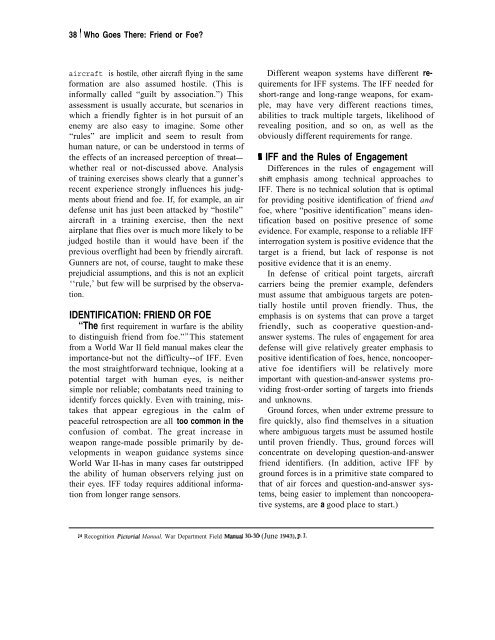Who Goes There: Friend or Foe? - Federation of American Scientists
Who Goes There: Friend or Foe? - Federation of American Scientists
Who Goes There: Friend or Foe? - Federation of American Scientists
You also want an ePaper? Increase the reach of your titles
YUMPU automatically turns print PDFs into web optimized ePapers that Google loves.
38 I <strong>Who</strong> <strong>Goes</strong> <strong>There</strong>: <strong>Friend</strong> <strong>or</strong> <strong>Foe</strong>?<br />
aircraft is hostile, other aircraft flying in the same<br />
f<strong>or</strong>mation are also assumed hostile. (This is<br />
inf<strong>or</strong>mally called “guilt by association.”) This<br />
assessment is usually accurate, but scenarios in<br />
which a friendly fighter is in hot pursuit <strong>of</strong> an<br />
enemy are also easy to imagine. Some other<br />
“rules” are implicit and seem to result from<br />
human nature, <strong>or</strong> can be understood in terms <strong>of</strong><br />
the effects <strong>of</strong> an increased perception <strong>of</strong> threat—<br />
whether real <strong>or</strong> not-discussed above. Analysis<br />
<strong>of</strong> training exercises shows clearly that a gunner’s<br />
recent experience strongly influences his judgments<br />
about friend and foe. If, f<strong>or</strong> example, an air<br />
defense unit has just been attacked by “hostile”<br />
aircraft in a training exercise, then the next<br />
airplane that flies over is much m<strong>or</strong>e likely to be<br />
judged hostile than it would have been if the<br />
previous overflight had been by friendly aircraft.<br />
Gunners are not, <strong>of</strong> course, taught to make these<br />
prejudicial assumptions, and this is not an explicit<br />
‘‘rule,’ but few will be surprised by the observation.<br />
IDENTIFICATION: FRIEND OR FOE<br />
‘‘The first requirement in warfare is the ability<br />
to distinguish friend from foe.” 14<br />
This statement<br />
from a W<strong>or</strong>ld War II field manual makes clear the<br />
imp<strong>or</strong>tance-but not the difficulty--<strong>of</strong> IFF. Even<br />
the most straightf<strong>or</strong>ward technique, looking at a<br />
potential target with human eyes, is neither<br />
simple n<strong>or</strong> reliable; combatants need training to<br />
identify f<strong>or</strong>ces quickly. Even with training, mistakes<br />
that appear egregious in the calm <strong>of</strong><br />
peaceful retrospection are all too common in the<br />
confusion <strong>of</strong> combat. The great increase in<br />
weapon range-made possible primarily by developments<br />
in weapon guidance systems since<br />
W<strong>or</strong>ld War II-has in many cases far outstripped<br />
the ability <strong>of</strong> human observers relying just on<br />
their eyes. IFF today requires additional inf<strong>or</strong>mation<br />
from longer range sens<strong>or</strong>s.<br />
14 Recognition Picton’ai Manual, War Department Field Wutd 30-30 (June 1943), P. 1.<br />
Different weapon systems have different requirements<br />
f<strong>or</strong> IFF systems. The IFF needed f<strong>or</strong><br />
sh<strong>or</strong>t-range and long-range weapons, f<strong>or</strong> example,<br />
may have very different reactions times,<br />
abilities to track multiple targets, likelihood <strong>of</strong><br />
revealing position, and so on, as well as the<br />
obviously different requirements f<strong>or</strong> range.<br />
~ IFF and the Rules <strong>of</strong> Engagement<br />
Differences in the rules <strong>of</strong> engagement will<br />
shift emphasis among technical approaches to<br />
IFF. <strong>There</strong> is no technical solution that is optimal<br />
f<strong>or</strong> providing positive identification <strong>of</strong> friend and<br />
foe, where “positive identification” means identification<br />
based on positive presence <strong>of</strong> some<br />
evidence. F<strong>or</strong> example, response to a reliable IFF<br />
interrogation system is positive evidence that the<br />
target is a friend, but lack <strong>of</strong> response is not<br />
positive evidence that it is an enemy.<br />
In defense <strong>of</strong> critical point targets, aircraft<br />
carriers being the premier example, defenders<br />
must assume that ambiguous targets are potentially<br />
hostile until proven friendly. Thus, the<br />
emphasis is on systems that can prove a target<br />
friendly, such as cooperative question-andanswer<br />
systems. The rules <strong>of</strong> engagement f<strong>or</strong> area<br />
defense will give relatively greater emphasis to<br />
positive identification <strong>of</strong> foes, hence, noncooperative<br />
foe identifiers will be relatively m<strong>or</strong>e<br />
imp<strong>or</strong>tant with question-and-answer systems providing<br />
frost-<strong>or</strong>der s<strong>or</strong>ting <strong>of</strong> targets into friends<br />
and unknowns.<br />
Ground f<strong>or</strong>ces, when under extreme pressure to<br />
fire quickly, also find themselves in a situation<br />
where ambiguous targets must be assumed hostile<br />
until proven friendly. Thus, ground f<strong>or</strong>ces will<br />
concentrate on developing question-and-answer<br />
friend identifiers. (In addition, active IFF by<br />
ground f<strong>or</strong>ces is in a primitive state compared to<br />
that <strong>of</strong> air f<strong>or</strong>ces and question-and-answer systems,<br />
being easier to implement than noncooperative<br />
systems, are a good place to start.)
















